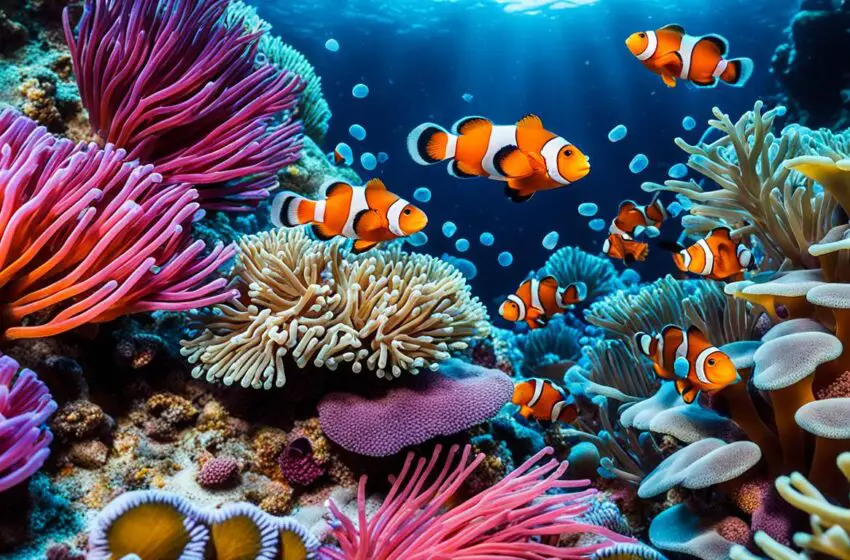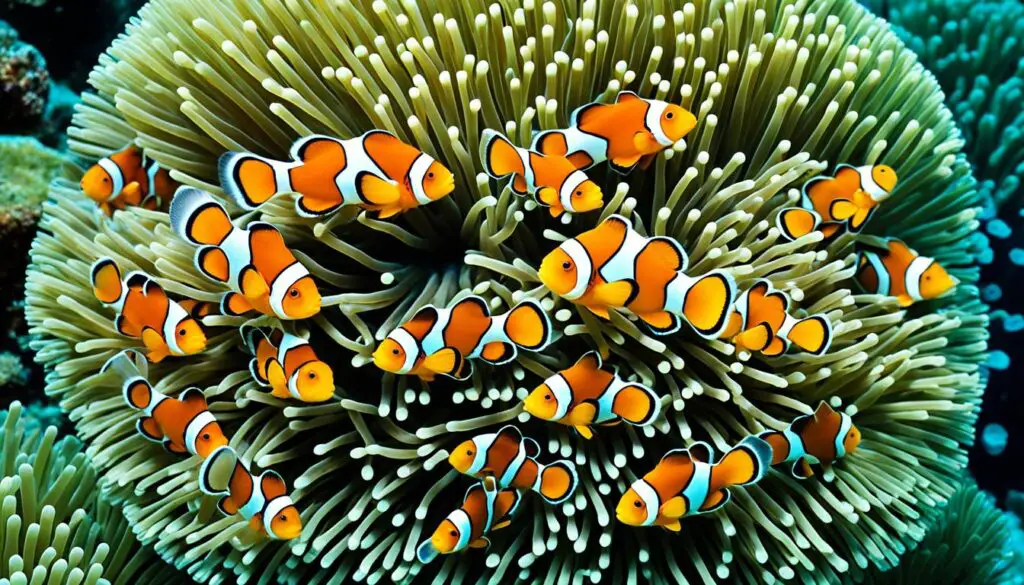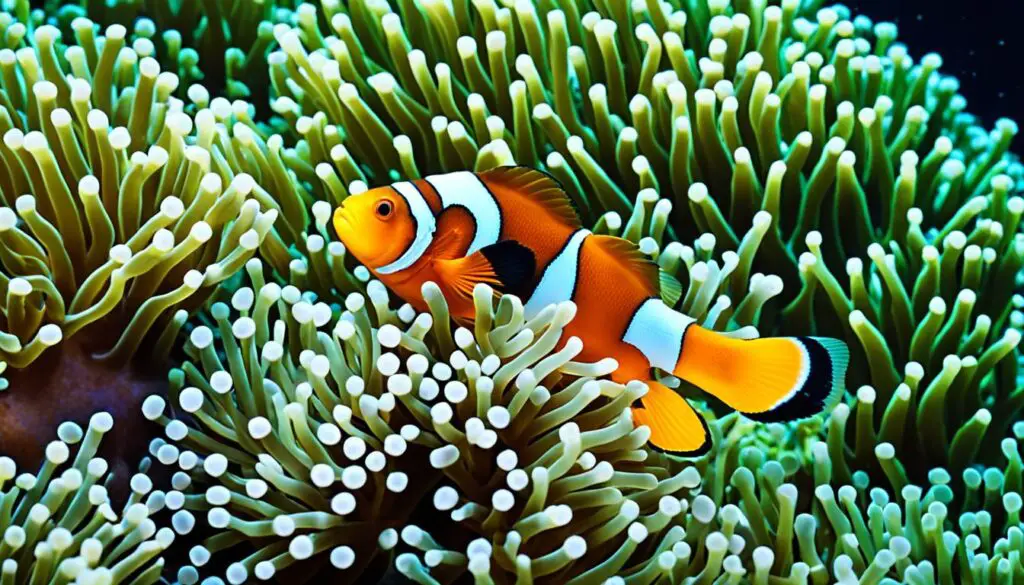Dive into Clownfish Feeding Habits: Insider Secrets

Clownfish are famous in the world of saltwater fish. They are loved for their bright colors and how they eat. These fish are part of the damselfish family and live in coral reefs, making the ocean even more beautiful.
There are over 30 kinds of clownfish. Each one is unique, adding something special to any tank.
What’s cool about clownfish is what they eat. They have a varied diet, eating both plants and animals. Their food is key to keeping them healthy, making their feeding habits very important.
Clownfish and sea anemones have a pretty cool relationship. The fish hide in the anemones to stay safe from bigger fish. They also help the anemones by keeping them clean and feeding them with their waste. It’s a win-win for both creatures.
Even though not all clownfish need anemones to live well in tanks, some can benefit from them. Yet, they can also get by with other things like corals or rocks. They use these to make their own little safe spots when anemones aren’t around.
Key Takeaways:
- Clownfish are popular saltwater fish with vibrant colors and unique feeding habits.
- They belong to the damselfish family and can be found in coral reefs.
- There are over 30 identified species of clownfish, each with its own distinct characteristics.
- Clownfish have a symbiotic relationship with sea anemones, providing protection and nutrients.
- While they can be kept in aquariums without anemones, some species may benefit from their presence.
The Complexities of Clownfish Complexes – 6 Main Groups
Clownfish come in six main complex types based on their unique features. Knowing these helps pick the right ones for your tank.
The Skunk Complex
The Skunk Complex includes the Pink Skunk and Orange Skunk clownfish. They have bright colors and look like skunks with their stripes. They are small and good for new fish keepers.
The Percula Complex
The Percula Complex has the famous True Percula and unique Picasso clownfish. The True Percula is orange with black stripes. The Picasso has varied patterns and is a favorite among fish collectors.
The Maroon Complex
The Maroon Complex has the Maroon Clownfish and Gold Striped Maroon Clownfish. They are deep red and can be quite bossy. They need special care when introduced.
The Clarkii Complex
Clark’s Clownfish and Three-Band Clownfish belong to the Clarkii Complex. Clark’s is bright orange with three white stripes. Three-Band is orange-yellow with three black stripes. They are tough and good for beginer aquarists.
The Saddleback Complex
The Saddleback Complex includes the Sebae Clownfish. It’s known for its saddle-like marking. These clownfish can be aggressive with other fish.
The Tomato Complex
The Tomato Complex has the Tomato and Cinnamon Clownfish. The Tomato is red-orange. The Cinnamon is dark brown with light brown highlights. They are tough and do well in tanks.
Each clownfish complex has unique traits, colors, and needs. Knowing these helps you choose the best ones for your tank.
Stay tuned for the next section, where we explore the unique relationship between clownfish and sea anemones.
No Laughing Matter – Clownfish and Sea Anemones
Clownfish and sea anemones share a unique bond. Unlike other sea life, clownfish are not hurt by the poison in anemones’ tentacles. They live there safely, using the anemone as a shield. In turn, they protect the anemone, keep it clean, and enrich it with their waste.
In aquariums, some clownfish do well even if there’s no anemone. But, many benefit from having one around. When setting up a tank, it’s key to think about this partnership. You should choose anemones that certain clownfish, like Sebae Anemone, will like.
Anemone Selection for Clownfish
Picking the right anemone is crucial for your clownfish. Some clownfish types prefer certain anemones. It’s good to know what your clownfish likes before you set up their home.
Look into where your clownfish is from to pick the best anemones. Make sure the anemone isn’t too big or aggressive. It should fit well in the tank without bothering other fish.
Forming a Symbiotic Bond
“The symbiotic relationship between clownfish and anemones is truly fascinating. They depend on each other for protection and survival, showcasing a remarkable example of nature’s interconnectedness.” – Marine biologist, Dr. Jane Roberts
The right setup helps the clownfish and anemone bond. Good water, hiding places, and proper food for both are essential. This helps their partnership grow strong.
But not every clownfish needs an anemone to do well. For example, the Ocellaris clownfish (often called Nemo) can be happy in a tank without one.
The Fascinating World of Clownfish and Anemones
The connection between clownfish and anemones is truly amazing. Even if you don’t put anemones in your tank, it’s great to see the bond they share. It shows how nature’s creatures depend on each other.
Learning about this partnership makes your aquarium more than just a tank. It’s a home for incredible sea life. It highlights the beauty and balance of the marine world.
The Captive Clownfish – Facts Every Aquarist Should Know
Captive clownfish are a top choice for many hobbyists. They’re often easier to care for than those caught in the wild. This is because they are bred in tanks, which means they are used to that kind of life. This make them less risky to keep.
Clownfish are mainly friendly, but they can get touchy about their space. So, it’s key to pick the right ones to live together peacefully. This avoids fights and keeps everyone happy.
Contrary to common views, most clownfish don’t need anemones to be healthy. They can do well in smaller tanks without these. But, they do need a mix of foods to be at their best. Make sure they get both live and dry foods to stay brightly colored and healthy.
Did you know clownfish can change their sex? If the main female goes away, the biggest male becomes a female. This keeps the group breeding and makes clownfish even more interesting to watch.
Keeping clownfish can be both fun and fulfilling. They are easy to have babies with in tanks. With the right food and care, they’ll make your home aquarium a beautiful and lively place.
FAQ
What do clownfish eat?
Clownfish eat a mix of small creatures, plants, and bits of leftover food in the water. In tanks, you can give them things like brine shrimp, mysis shrimp, and copepods. They also like special fish food. This diet keeps them healthy and happy.
How many species of clownfish are there?
There are more than 30 kinds of clownfish. Each one is unique, with different looks and traits. You might recognize some, like the True Percula or the Tomato Clownfish. They stand out because of their bright colors.
Do clownfish need anemones?
Clownfish don’t need anemones to do well in tanks. Even though they live with them in the ocean, they can live happily without. But, some clownfish do better, showing off their real colors and habits, with anemones around.
Can I keep multiple clownfish together?
Yes, you can keep several clownfish in a big tank. But, it’s key to either introduce them all together or have a known pair. This prevents fights. Make sure the tank has plenty of places to hide and claim as their own.
Are captive bred clownfish better for aquariums?
Having clownfish bred in captivity is good for tanks. They do well in home aquariums. They are stronger and get sick less than those caught from the wild. Using them also helps protect the ocean’s reefs.
Can clownfish change genders?
Clownfish can actually change from male to female if needed. The biggest and most powerful male can become female. This happens when the top female in the group goes away or dies. It’s a cool way they adapt and survive.



